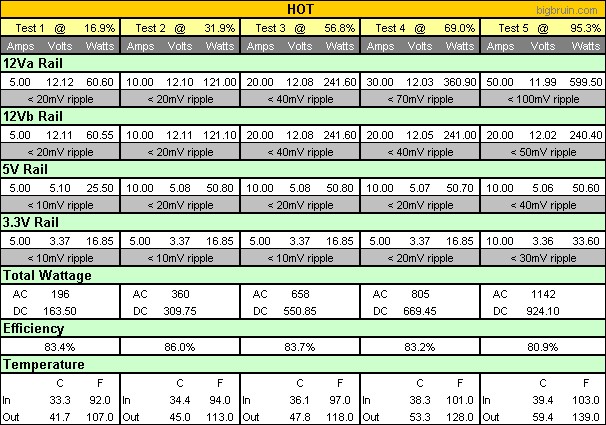Testing (continued):
This paragraph is intended to be a guide to reading the charts below. The heading "COLD" in blue and "HOT" in orange indicate whether the test was done at ambient temperature or with the additional heat at the inlet. On the next line we see a yellow background with the test number and a percentage in each box. The steps chosen do not correspond to a typical percentage you might expect (for example, 25% or 50%), but were chosen to be nice round Amperage values to dial in to the loaders that took into consideration the limits of the test equipment, the ratings of each rail, and the combined rail ratings. The percentage value is that of the total load calculated by dividing the total DC Wattage by 970 (the total combined power on the 12V, 5V, and 3.3V rails). The next area on the chart details the electrical data for the three main rails as they were divided up among the four loaders. There are six 12V rails, but with the test equipment on hand some had to be combined. 12Va represents five of the rails on one 750W loader, and 12Vb represents one of the rails on a 300W loader. In gray below each entry for Amps, Volts, and Watts we see a ripple value as described previously. Below the entries for all three Voltage rails we see a Total Wattage field. AC power was read from the AC power monitor, while DC power was calculated by summing the values from the three rails during that test. Dividing this DC power value by the AC power value gives us the efficiency (shown in the next field down), while dividing this DC power value by 970 is where we get the percentage shown at the top of each column. In the final field we see the inlet and outlet temperatures (logged in F, and converted to C).

For the COLD test we see that the unit was tested up to 922W, or 95.1% of its capacity. The regulation on all three rails was very good, with the 12V rails ranging from 12.12 to 11.97V, the 5V rail ranging from 5.10V to 5.02V, and the 3.3V rail ranging from 3.37V to 3.36V. The maximum allowable ripple on the 5V and 3.3V rails is 50mV, while it is 120mV on the 12V rail. While I will not claim to have the most accurate ripple readings, they are good ballpark figures. And what we see is that while everything stayed within specification, the 5V and 12V rails did get closer to the maximum than you might want to see. As for the efficiency, the unit stayed above 80% during all tests, and might actually be good enough for 80 PLUS Bronze. I didn't test right at 50% of load (where you need an 85% efficiency), but at 56.7% of full load I did monitor an efficiency of 84.5%. Taking into account my non-standard test method and all the other real-world variables, I wouldn't dispute the 80 PLUS Bronze rating despite my test results.

For the HOT test we see the same basic trends from the COLD test. The regulation gets a bit better as compared to the COLD test, with the 12V rails ranging from 12.12 to 11.99V, the 5V rail ranging from 5.10V to 5.06V, and the 3.3V rail ranging from 3.37V to 3.36V. The ripple gets a bit worse on the 12V and 3.3V rails, and although everything remains with specification, the 12V and 5V rails are closer to the maximum allowable than you might want to see. Efficiency drops slightly across the board, but stayed above 80% at all times. Factoring in a plus/minus tolerance of a few percentage points given my setup, I would still be inclined to accept the 80 PLUS Bronze rating despite not getting there with the review sample.